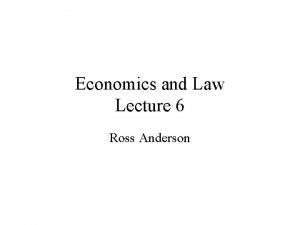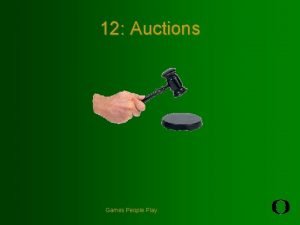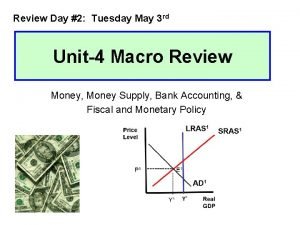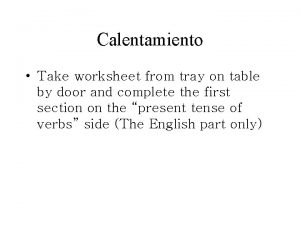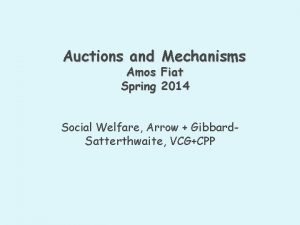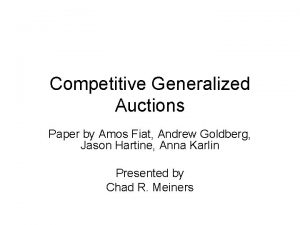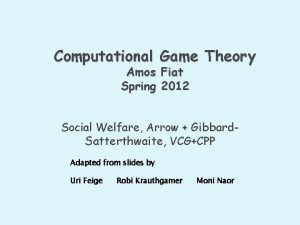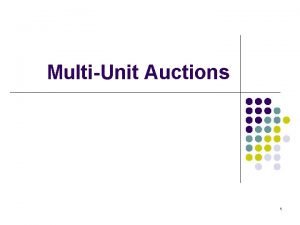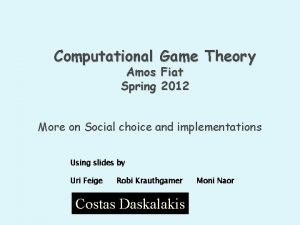Auctions and Mechanisms Amos Fiat Spring 2014 Social












































- Slides: 44

Auctions and Mechanisms Amos Fiat Spring 2014 Social Welfare, Arrow + Gibbard. Satterthwaite, VCG+CPP 1

Social choice or Preference Aggregation Collectively choose among outcomes Participants have preferences over outcomes A social choice function aggregates those preferences and picks an outcome ◦ ◦ ◦ Elections, Choice of Restaurant Rating of movies Who is assigned what job Goods allocation Should we build a bridge?

Voting If there are two options and an odd number of voters Each having a clear preference between the options Natural choice: majority voting Sincere/Truthful Monotone Merging two sets where the majorities are the same preserves majority Order of queries has no significance

When there are more than two options: If we start pairing the alternatives: a 10, a 1, … , a 8 Order may matter Assumption: n voters give their complete ranking on set A of alternatives L – the set of linear orders on A (permutations). Each voter i provides Ái 2 L ◦ Input to the aggregator/voting rule is (Á1, Á2, … , Án ) am a 2 a 1 A Goals A function f: Ln A is called a social choice function ◦ Aggregates voters preferences and selects a winner A function W: Ln L is called a social welfare function ◦ Aggergates voters preference into a common order

Examples of voting rules Scoring rules: defined by a vector (a 1, a 2, …, am) Being ranked ith in a vote gives the candidate ai points • Plurality: defined by (1, 0, 0, …, 0) – Winner is candidate that is ranked first most often • Veto: is defined by (1, 1, …, 1, 0) – Winner is candidate that is ranked last the least often • Borda: defined by (m-1, m-2, …, 0) Jean-Charles de Borda 1770 Plurality with (2 -candidate) runoff: top two candidates in terms of plurality score proceed to runoff. Single Transferable Vote (STV, aka. Instant Runoff): candidate with lowest plurality score drops out; for voters who voted for that candidate: the vote is transferred to the next (live) candidate Repeat until only one candidate remains

Marquis de Condorcet Marie Jean Antoine Nicolas de Caritat, marquis de Condorcet 1743 -1794 There is something wrong with Borda! [1785]

Condorcet criterion • A candidate is the Condorcet winnerif it wins all of its pairwise elections • Does not always exist… Condorcet paradox: there can be cycles – Three voters and candidates: a > b > c, b > c > a, c > a > b – a defeats b, b defeats c, c defeats a Many rules do not satisfy the criterion • For instance: plurality: – b>a>c>d – c>a>b>d – d>a>b>c • Candidates a and b: • Comparing how often a is ranked above b, to how often b is ranked above a Also Borda: a>b>c>d>e c>b>d>e>a • a is the Condorcet winner, but not the plurality winner

Even more voting rules… • Kemeny: – Consider all pairwise comparisons. – Graph representation: edge from winner to loser – Create an overall ranking of the candidates that has as few disagreements as possible with the pairwise comparisons. • Delete as few edges as possible so as to make the directed comparison graph acyclic • Honor societies • General Secretary of the UN • Approval [not a ranking-based rule]: every voter labels each candidate as approved or disapproved. Candidate with the most approvals wins How do we choose one rule from all of these rules? • What is the “perfect” rule? • We list some natural criteria

Arrow’s Impossibility Theorem Skip to the 20 th Centrury Kenneth Arrow, an economist. In his Ph. D thesis, 1950, he: ◦ Listed desirable properties of voting scheme ◦ Showed that no rule can satisfy all of them. Properties Unanimity Independence of irrelevant alternatives Not Dictatorial Kenneth Arrow 1921 -

Independence of irrelevant alternatives • Independence of irrelevant alternatives: if – the rule ranks a above b for the current votes, – we then change the votes but do not change which is ahead between a and b in each vote then a should still be ranked ahead of b. • None of our rules satisfy this property – Should they? b a a ¼ a b a b b b a

Arrow’s Impossibility Theorem Every Social Welfare Function. W over a set A of at least 3 candidates: If it satisfies – Independence of irrelevant alternatives – Pareto efficiency: If for all i a Ái b then a Á b where W(Á1, Á2, … , Án ) = Á Then it is dictatorial : for all such W there exists an index i such that for all Á1, Á2, … , Án 2 L, W(Á1, Á2, … , Án ) = Ái

Proof of Arrow’s Theorem Claim: Let W be as above, and let Á1, Á2, …, Án and Á’ 1, Á’ 2, …, Á’n be two profiles s. t. ◦ Á=W(Á1, Á2, …, Án) and Á’=W(Á’ 1, Á’ 2, …, Á’n) ◦ and where for all i a Ái b c Á’i d Then a Á b c Á’ d Proof: suppose a Á b and c b Create a single preference i from Ái and Á’i: where c is just below a and d just above b. Let Á =W(Á1, Á2, …, Án) We must have: (i) a Á b (ii) c Á a and (iii) b Á d And therefore c Á d and c Á’ d

Proof of Arrow’s Theorem: Find the Dictator Claim: For arbitrary a, b 2 A consider profiles Voters 1 2 b a a b b b a a … n b b a 0 aÁb 1 Change must happen at some profile i* • Where voter i* changed his opinion a a b 2 n Profiles Hybrid argument Claim: this i* is the dictator! bÁa

Proof of Arrow’s Theorem: i* is the dictator Claim: for any Á1, Á2, …, Án and Á=W(Á1, Á2, …, Án) and c, d 2 A. If c Ái* d then c Á d. Proof: take e c, d and for i<i* move e to the bottom of Ái for i>i* move e to the top of Ái for i* put e between c and d cÁe For resulting preferences: ◦ Preferences of e and c like a and b in profile i*. ◦ Preferences of e and d like a and b in profile i*-1. eÁd Therefore c Ád

Social welfare vs. Social Choice A function f: Ln A is called a social choice function ◦ Aggregates voters preferences and selects a winner A function W: Ln L is called a social welfare function ◦ Aggergates voters preference into a common order We’ve seen: Next: ◦ Arrows Theorem: Limitations on Social Welfare functions ◦ Gibbard-Satterthwaite Theorem: Limitations on Incentive Compatible Social Choice functions 15

Strategic Manipulations A social choice function f can be manipulated by voter i if for some Á1, Á2, …, Án and Á’i and we have a=f(Á1, …Ái, …, Án) and a’=f(Á1, …, Á’i, …, Án) but a Ái a’ voter i prefers a’ over a and can get it by changing her vote from her true preference Ái to Á’i f is called incentive compatible if it cannot be manipulated

Gibbard-Satterthwaite Impossibility Theorem • Suppose there at least 3 alternatives • There exists no social choice functionf that is simultaneously: – Onto • for every candidate, there are some preferences so that the candidate alternative is chosen – Nondictatorial – Incentive compatible

Proof of the Gibbard-Satterthwaite Theorem: Via Contradiction to Arrow Given non-manipulable, onto, non dictator social choice function f, Construct a Social Welfare function Wf (total order) based on f. Wf(Á1, …, Án) =Á where aÁb iff f(Á1{a, b}, …, Án{a, b}) =b Keep everything in order but move a and b to top

What we need to show That ◦ ◦ ◦ is “well formed” Antisymmetry Transitivity Unanimity IIA Non-dictatorship Contradiction to Arrow 19

Proof of the Gibbard-Satterthwaite Theorem Claim: for all Á1, …, Án and any S ½ A we have f(Á1 S, …, Án. S, ) 2 S Keep everything in order but move elements of S to top Take a 2 S. There is some Á’ 1, Á’ 2, …, Á’n where f(Á’ 1, Á’ 2, …, Á’n)=a. Sequentially change Á’i to ÁSi • At no point does f output b 2 S. • Due to the non-manipulation

Proof of Well Form Lemma Antisymmetry: implied by claim for S={a, b} Transitivity: Suppose we obtained contradicting cycle a Á b Á c Á a take S={a, b, c} and suppose a = f(Á1 S, …, Án. S) Sequentially change ÁSi to Ái{a, b} Non manipulability implies that f(Á1{a, b}, …, Án{a, b}) =a and b Á a. Unanimity: if for all i b Ái a then (Ái{a, b}){a} =Ái{a, b} and f(Á1{a, b}, …, Án{a, b}) =a

Proof of Well Form Lemma Independence of irrelevant alternatives: ◦ Again, non-manulpulation, ◦ if there are two profiles Á1, Á2, …, Án and Á’ 1, Á’ 2, …, Á’n where for all i bÁi a iff bÁ’i a, then f(Á1{a, b}, …, Án{a, b}) = f(Á’ 1{a, b}, …, Á’n{a, b}) by sequentially flipping from Ái{a, b} to Á’i{a, b} Non dictator: preserved

Mechanism Design 23

Social choice in the quasi linear setting Set of alternatives A ◦ Who wins the auction ◦ Which path is chosen ◦ Who is matched to whom Each participant: a type function ti: A R ◦ Note: real value, not only order Participant = agent/bidder/player/etc.

Mechanism Design We want to implement a social choice function ◦ (a function of the agent types) ◦ Need to know agents’ types ◦ Why should they reveal them? Idea: Compute alternative (a in A) and payment vector p Utility to agent i of alternative a with payment pi is ti(a)-pi Quasi linear preferences

The setting A social planner wants to choose an alternative according to players’ types: f : T 1 ×. . . × Tn → A Problem: the planner does not know the types.

Example: Vickrey’s Second Price Auction Single item for sale Each player has scalar value zi – value of getting item If he wins item and has to pay p: utility zi-p If someone else wins item: utility 0 Second price auction: Winner is the one with the highest declared value zi. Pays the second highest bid p*=maxj i zj Theorem (Vickrey): for any everyz 1, z 2, …, zn and every zi’. Let ui be i’s utility if he bidszi and u’i if he bids zi’. Then ui ¸ u’i. .

Direct Revelation Mechanism A direct revelation mechanism is a social choice function f: T 1 T 2 … Tn A and payment functions pi: T 1 T 2 … Tn R Participant i pays pi(t 1, t 2, … tn) t=(t 1, t 2, … tn) t-i=(t 1, t 2, … ti-1 , ti+1 , … tn) A mechanism (f, p 1, p 2, … pn) is incentive compatible in dominant strategies if for every t=(t 1, t 2, …, tn), i and ti’ 2 Ti: if a = f(ti, t-i) and a’ = f(t’i, t-i) then ti(a)-pi(ti, t-i) ¸ ti(a’) -pi(t’i, t-i)

Vickrey Clarke Grove Mechanism A mechanism (f, p 1, p 2, … pn ) is called Vickrey. Clarke-Grove (VCG) if f(t 1, t 2, … tn) maximizes i ti(a) over A ◦ Maximizes welfare There are functions h 1, h 2, … hn where hi: T 1 T 2 … Ti-1 Ti+1 … Tn R we have that: pi(t 1, t 2, … tn) = hi(t-i) - j i tj(f(t 1, t 2, … tn)) Does not depend on ti t=(t 1, t 2, … tn) t-i=(t 1, t 2, … ti-1 , ti+1 , … tn)

Example: Second Price Auction Recall: f assigns the item to one participant and ti(j) = 0 if j i and ti(i)=zi A={i wins|I 2 I} f(t 1, t 2, … tn) = i s. t. zi =maxj(z 1, z 2, … zn) hi(t-i) = maxj(z 1, z 2, … zi-1, zi+1 , …, zn) pi(t) = hi(v-i) - j i tj(f(t 1, t 2, … tn)) If i is the winner pi(t) = hi(t-i) = maxj i zj and for j i pj(t)= zi – zi = 0

VCG is Incentive Compatible Theorem : Every VCG Mechanism (f, p 1, p 2, … pn) is incentive compatible Proof: Fix i, t-i, ti and t’i. Let a=f(ti, t-i) and a’=f(t’i, t-i). Have to show ti(a)-pi(ti, t-i) ¸ ti (a’) -pi(t’i, t-i) Utility of i when declaring ti: ti(a) + j i tj(a) - hi(t-i) Utility of i when declaring t’i: ti(a’)+ j i tj(a’)- hi(t-i) Since a maximizes social welfare ti(a) + j i tj(a) ¸ ti(a’) + j i tj(a’)

Clarke Pivot Rule What is the “right”: h? Individually rational : participants always get non negative utility ti(f(t 1, t 2, … tn)) - pi(t 1, t 2, … tn) ¸ 0 No positive transfers: no participant is ever paid money pi(t 1, t 2, … tn) ¸ 0 Clark Pivot rule: Choosing hi(t-i) = maxb 2 A j i tj(b) Payment of i when a=f(t 1, t 2, …, tn): pi(t 1, t 2, … tn) = maxb 2 A j i tj(b) - j i tj(a) i pays an amount corresponding to the total “damage” he causes other players: difference in social welfare caused by his participation

Rationality of Clarke Pivot Rule Theorem : Every VCG Mechanism with Clarke pivot payments makes no positive Payments. If ti(a) ¸ 0 then it is Individually rational maximizes i ti(a) over A Proof: Let a=f(t 1, t 2, … tn) maximize social welfare Let b 2 A maximize j i tj(b) Utility of i: ti(a) + j i tj(a) - j i tj(b) ¸ j tj(a) - j tj(b) ¸ 0 Payment of i: j i tj(b) - j i tj(a) ¸ 0 from choice of b

Examples: Second Price Auction Second Price auction: hi(t-i) = maxj(w 1, w 2, …, wi-1, wi+1, …, wn) = maxb 2 A j i tj(b) Multiunit auction : if k identical items are to be sold to k individuals. A={S wins |S ½ I, |S|=k} and vi(S) = 0 if i 2 S and vi(i)=wi if i 2 S Allocate units to top k bidders. They pay the k+1 st price Claim: this is max. S’ ½ I{i} |S’| =k j i vj(S’)- j i vj(S)

Generalized Second Price Auctions

VCG with Public Project Want to build a bridge: ◦ Cost is C (if built) (One more player – the “state”) A={build, not build} ◦ Value to each individual vi ◦ Want to built iff i vj ¸ C Player with vj ¸ 0 pays only if pivotal j i vj < C but j vj ¸ C in which case pays pj = C- j i vj In general: i pj < C Equality only when i vj = C Payments do not cover project cost’s Subsidy necessary!

Buying a (Short) Path in a Graph A Directed graph G=(V, E) where each edge e is “owned” by a different player and has cost ce. Want to construct a path from source s to destination t. Set A of alternatives: all s -t paths How do we solicit the real cost ce? ◦ Set of alternatives: all paths from s to t ◦ Player e has cost: 0 if e not on chosen path and –ce if on ◦ Maximizing social welfare: finding shortest s-t path: min paths e 2 path ce A VCG mechanism pays 0 to those not on path p: pay each e 0 2 p: e 2 p’ ce - e 2 p{e } ce where p’ is shortest path without eo 0 If e 0 would not have woken up in the morning, what would other edges earn? If he does wake up, what would other edges earn?

VCG (+CPP) is not perfect • Requires payments & quasilinear utility functions • In general money needs to flow away from the system – Strong budget balance = payments sum to 0 – Impossible in general [Green & Laffont 77] • Vulnerable to collusions • Maximizes sum of players’ valuations (social welfare) – (not counting payments, but does include “COST” of alternative) But: sometimes [usually, often? ? ] the mechanism is not interested in maximizing social welfare: – – E. g. the center may want to maximize revenue Minimize time Maximize fairness Etc. , Etc.

Bayes Nash Implementation 39

Bayes Nash Implementation There is a distribution Di on the types Ti of Player i It is known to everyone The actual type of agent i, ti 2 Di. Ti is the private information i knows A profile of strategis si is a Bayes Nash Equilibrium if for i all ti and all t’i Ed-i[ui(ti, si(ti), s-i(t-i) )] ¸ Ed-i[ui(t’i, s-i(t-i)) ]

Bayes Nash: First Price Auction First price auction for a single item with two players. Private values (types) t 1 and t 2 in T 1=T 2=[0, 1] Does not make sense to bid true value – utility 0. There are distributions D 1 and D 2 Looking for s 1(t 1) and s 2(t 2) that are best replies to each other Suppose both D 1 and D 2 are uniform. Claim: The strategies s 1(t 1) = ti/2 are in Bayes Nash Equilibrium Win half the time t 1 Cannot win

Characterization of Equilibria 42

Characterization of Equilibria 43

Expected Revenues Expected Revenue: ◦ For first price auction: max(T 1/2, T 2/2) where T 1 and T 2 uniform in [0, 1] ◦ For second price auction min(T 1, T 2) ◦ Which is better? ◦ Both are 1/3. ◦ Coincidence? Theorem [Revenue Equivalence] : under very general conditions, every two Bayesian Nash implementations of the same social choice function if for some player and some type they have the same expected payment then ◦ All types have the same expected payment to the player ◦ If all player have the same expected payment: the
 Amos fiat
Amos fiat Kim ki duk spring summer fall winter
Kim ki duk spring summer fall winter Summer autumn winter
Summer autumn winter Susan mains artist
Susan mains artist Type of auctions
Type of auctions Baystate auctions
Baystate auctions Kista bus sales
Kista bus sales Dtting
Dtting Ecommerce online auctions
Ecommerce online auctions Ecomuseum
Ecomuseum Anderson auctions
Anderson auctions Play auctions
Play auctions Hisd spring break 2014
Hisd spring break 2014 External social control
External social control Fiat prayer
Fiat prayer P1523 fiat 500
P1523 fiat 500 500 pop
500 pop Link entry fiat aftersales
Link entry fiat aftersales Fiat delft
Fiat delft Fiat doblo dpf regeneration procedure
Fiat doblo dpf regeneration procedure Skala likerta przykład
Skala likerta przykład What is fiat money
What is fiat money What is fiat money
What is fiat money What is fiat money
What is fiat money What is a fiat currency
What is a fiat currency Principles of social services and wellbeing act wales
Principles of social services and wellbeing act wales Social services and wellbeing (wales) act 2014 easy read
Social services and wellbeing (wales) act 2014 easy read How is janie treated as the mayor’s wife?
How is janie treated as the mayor’s wife? Social thinking and social influence
Social thinking and social influence Social thinking social influence social relations
Social thinking social influence social relations Estudio biblico amos 5
Estudio biblico amos 5 O as a amos an chart
O as a amos an chart Amos wang
Amos wang Seiichi nakajima
Seiichi nakajima Jan amos
Jan amos Bailey amos
Bailey amos Amós 3 3 matrimonios
Amós 3 3 matrimonios Jan amos
Jan amos Amos 8 11-12
Amos 8 11-12 O as a amos an
O as a amos an Amos paran
Amos paran Amos tutorial
Amos tutorial Amos 9:3
Amos 9:3 Amos 2 6-8
Amos 2 6-8 Amos 1:1-15
Amos 1:1-15










